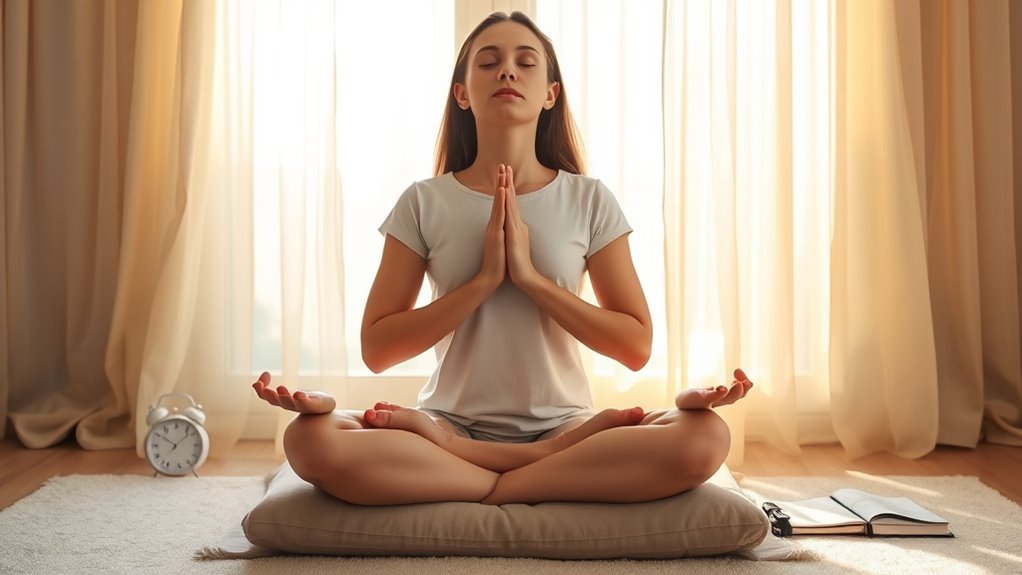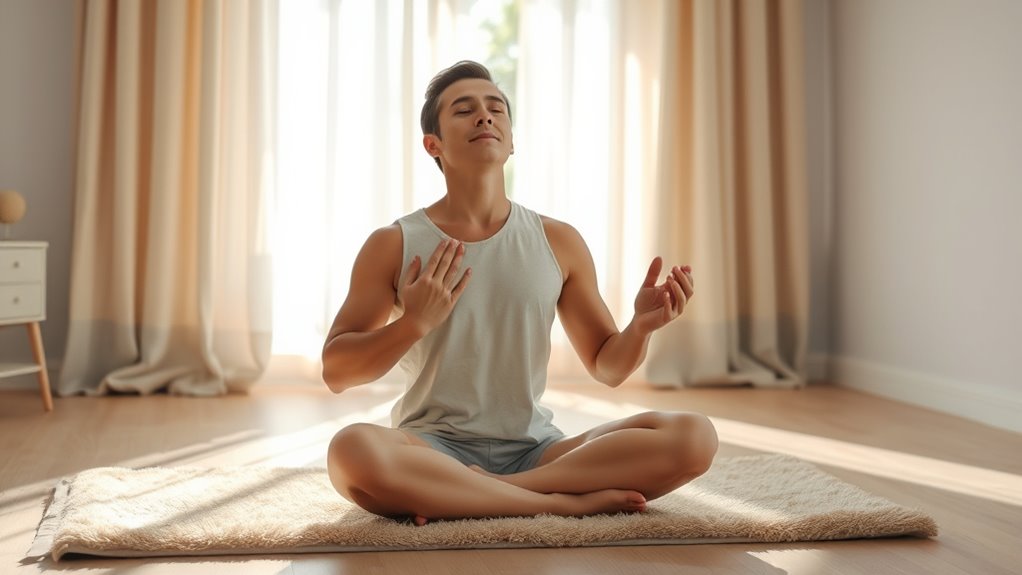To master breath control, start with diaphragmatic breathing by focusing on engaging your belly to breathe deeply and smoothly. Practice counting each inhale and exhale to develop a steady rhythm, and try techniques like the 4-7-8 method for relaxation or pursed-lip breathing to boost endurance. Incorporate these exercises into your daily routine to build strength and reduce stress. Keep practicing, and you’ll discover powerful ways to improve your breathing efficiency and overall well-being.
Key Takeaways
- Practice diaphragmatic (belly) breathing to strengthen breath support and improve lung capacity.
- Use counting techniques like 4-7-8 to develop steady, relaxed breathing rhythms.
- Incorporate pursed-lip breathing to enhance endurance and regulate airflow during physical activity.
- Engage in daily mindfulness and deep breathing exercises to reduce stress and increase breath awareness.
- Gradually integrate breathing exercises into routines to build consistency and maximize long-term respiratory benefits.
Understanding the Basics of Breath Control

Have you ever wondered how singers and speakers maintain steady, powerful voices? The key lies in understanding the basics of breath control. It starts with relaxation techniques that help reduce tension in your neck, shoulders, and chest. When you’re relaxed, your breathing becomes more efficient, allowing you to use your breath effectively. Incorporate simple vocal exercises to strengthen your breath support and improve control. These exercises often involve controlled inhaling and exhaling to develop awareness of your airflow. Remember, good breath control isn’t about force but about managing your breath smoothly and steadily. Practice regularly, focusing on staying relaxed, and you’ll notice your voice becoming clearer, stronger, and more resilient during performances or speeches. Additionally, exploring best anime movies can inspire you with storytelling techniques that emphasize pacing and emotional delivery, which relate to mastering rhythm in your speech or singing.
Diaphragmatic Breathing: Engaging Your Core

To master diaphragmatic breathing, you need to focus on deep belly engagement as you breathe in. Make sure you’re using proper technique by allowing your diaphragm to move freely without shallow chest rises. This way, you engage your core effectively and improve your overall breath control. Incorporating breath control techniques can further enhance your ability to regulate airflow efficiently.
Deep Belly Engagement
Engaging your core through diaphragmatic breathing helps you breathe more efficiently and deeply. When you focus on deep belly engagement, you activate your diaphragm, allowing air to flow fully into your lungs. This technique enhances meditation practices by promoting relaxation and mindfulness, while also improving vocal exercises by strengthening your breath support. To practice, place one hand on your belly and inhale slowly through your nose, feeling your abdomen rise as your diaphragm engages. Exhale steadily, noticing your belly fall. Regularly practicing deep belly engagement builds a solid foundation for better breath control in all areas of life. It helps you develop awareness of your core muscles, making your breathing more natural and effective during meditation, singing, or speaking.
Proper Breathing Technique
Proper breathing technique, especially diaphragmatic breathing, involves actively engaging your core muscles to optimize airflow. When you practice, focus on breath awareness to notice how your belly rises and falls with each inhale and exhale. This helps slow down fast breathing patterns and promotes deeper, more controlled breaths. Instead of shallow chest breathing, engage your diaphragm to draw air into your lungs fully. If you notice yourself taking rapid, shallow breaths, pause and consciously deepen each inhale, engaging your core muscles. This technique enhances oxygen exchange and calms your nervous system. Over time, diaphragmatic breathing becomes natural, helping you maintain proper form even during stress or exertion. Mastering this technique is essential for effective breath control and overall respiratory health.
Counting Breaths for Rhythm and Focus

Counting your breaths helps you establish a steady rhythm and stay present during practice. By using specific counts, you can improve your focus and keep your mind from wandering. This simple technique makes your breath control exercises more effective and calming. Incorporating mindful breath awareness during your practice can deepen relaxation and enhance mental clarity.
Establish Breathing Rhythm
To establish a steady breathing rhythm, focus on counting each inhale and exhale. This simple practice enhances your breath awareness and helps you stay present. Begin by inhaling slowly through your nose using proper inhalation techniques, filling your lungs completely. Then, exhale smoothly and fully, counting each breath cycle. As you do this, pay attention to the natural flow of your breath, avoiding force or strain. Consistent counting creates a pattern, making your breathing more controlled and focused. Over time, this rhythm becomes automatic, reducing stress and improving concentration. Remember, the goal is to stay attentive to your breath without rushing. With practice, you’ll develop a stable rhythm that anchors your mind and body in calmness and clarity.
Use Counting Techniques
Using counting techniques can greatly improve your ability to maintain a steady breathing rhythm and stay focused. By counting your breaths, you enhance breath awareness, making it easier to control your inhale and exhale. This method encourages you to synchronize your breath with a specific count, promoting consistency and rhythm. As you practice, you’ll notice your lung capacity increases, allowing for deeper, more efficient breaths. Counting also helps prevent shallow breathing caused by distraction or anxiety. Start by counting silently to four during each inhale, hold briefly, then exhale for the same count. Gradually, extend the counts as your lung capacity improves. This simple technique sharpens your focus and builds a solid foundation for advanced breath control exercises.
Enhance Concentration Focus
Have you ever noticed how your mind drifts when you focus on your breath? Counting breaths helps you build concentration and deepen mindfulness meditation. To stay engaged, assign a number to each inhale and exhale, creating a steady rhythm. Visualize this pattern:
| Inhale | Exhale |
|---|---|
| 1 | 2 |
| 3 | 4 |
| 5 | 6 |
| 7 | 8 |
Focusing on this count sharpens your attention and promotes stress reduction. When your mind wanders, gently bring it back to the counting. By anchoring yourself with breath rhythms, you enhance concentration and cultivate a calm, centered state. This simple exercise makes mindfulness meditation more effective, helping you stay present and focused.
The 4-7-8 Breathing Technique for Relaxation

The 4-7-8 breathing technique offers a simple yet powerful way to promote relaxation and reduce stress. By focusing on your breath, you can practice mindfulness meditation and calm your mind. To do this, sit comfortably and exhale completely through your mouth. Then, inhale quietly through your nose for four seconds. Hold your breath for seven seconds, feeling the tension ease away. Finally, exhale slowly through your mouth for eight seconds, releasing stress with each breath. Repeat this cycle four times to experience a calming effect. Consistent practice helps you stay present and centered, making it an effective tool for stress reduction. With consistent practice, you’ll notice feelings of relaxation spreading through your body, helping you handle daily stress more peacefully.
Pursed-Lip Breathing to Improve Endurance

Pursed-lip breathing is a simple yet effective technique that can help you improve your endurance during physical activity. The pursed lip technique involves inhaling slowly through your nose and exhaling through your pursed lips, as if blowing out a candle. This controlled exhalation keeps your airways open longer, reducing shortness of breath and improving oxygen exchange. Incorporating pursed-lip breathing into your endurance training allows you to sustain activity longer and recover more quickly. It also helps regulate your breathing pattern, making it more efficient during exertion. With consistent practice, you’ll notice greater stamina and less fatigue during workouts. This technique is especially beneficial for those engaging in aerobic activities or recovering from respiratory issues, providing a simple way to boost your overall endurance. Exclusions may apply for opened items and being aware of return policies can help in other areas of planning and convenience.
Incorporating Breath Control Into Daily Routine

Integrating breath control exercises into your daily routine can considerably enhance your overall well-being and respiratory health. Start by incorporating mindful meditation sessions that focus on deep, controlled breathing. Even just five minutes a day can help you become more aware of your breath and foster stress reduction. Practice simple techniques like diaphragmatic breathing during breaks or while commuting to stay relaxed and centered. Use these moments to slow down, breathe deeply, and reset your mind. Consistency is key; over time, this habit improves lung capacity and reduces anxiety. By making breath control a regular part of your day, you’ll notice increased calmness, better focus, and a healthier breathing pattern—benefits that extend beyond just physical health. Incorporating breath control exercises inspired by practices like Kia Tuning’s focus on performance enhancement can further optimize your respiratory efficiency.
Frequently Asked Questions
How Long Should Beginners Practice Each Breathing Exercise?
You might wonder how long to practice each breathing exercise. Aim for a practice duration of 5 to 10 minutes daily, gradually increasing as you feel comfortable. Consistency tips include setting a regular schedule and focusing on quality over quantity. Remember, regular, mindful practice helps you improve faster, so stay patient and persistent. Over time, you’ll notice better breath control and increased relaxation.
Are There Any Contraindications or Health Risks Associated With These Exercises?
Breathing exercises can feel like opening a window to fresh air, but watch out for hidden cobwebs. Some health risks and contraindications, like asthma or cardiovascular issues, might make certain exercises tricky or risky. Always listen to your body—if you feel dizzy or uncomfortable, pause and consult a healthcare professional. Safety first guarantees your journey to better breath control is smooth sailing, not stormy waters.
Can Breath Control Improve Athletic Performance Significantly?
Breath control can substantially boost your athletic performance by improving respiratory health and enhancing your athletic endurance. When you learn proper breathing techniques, your lungs work more efficiently, giving you better stamina during workouts or competitions. It also helps reduce fatigue and speeds up recovery. Incorporating breath exercises into your routine allows you to stay focused and maintain steady energy levels, ultimately elevating your overall athletic capabilities.
How Quickly Can Beginners Expect to See Results?
Ever wonder how soon you’ll notice improvements? With consistent practice, beginners can start seeing results in just a few weeks. Focusing on breath awareness and exercises to boost lung capacity helps you breathe more efficiently, which translates into better stamina and control. Keep practicing daily, and you’ll likely feel stronger and more in tune with your breath within a month. Are you ready to take your first deep breath toward progress?
Are There Specific Exercises for Managing Anxiety or Stress?
You can manage anxiety and stress effectively with specific exercises like mindfulness techniques and relaxation strategies. Try deep breathing exercises, focusing on slow, controlled breaths to calm your mind. Incorporate progressive muscle relaxation or guided imagery to ease tension. These practices help you stay present, reduce stress, and improve overall well-being. Consistently practicing these exercises will strengthen your ability to handle anxiety and promote a sense of calm in everyday life.
Conclusion
Now that you’ve learned these breath control exercises, imagine yourself standing tall, lungs filling effortlessly like a gentle wave washing over the shore. With each mindful inhale and steady exhale, you’re building a calming rhythm that grounds you amidst life’s chaos. Feel the air energize your body and clear your mind, turning breathing into a powerful tool for relaxation and focus. Embrace these techniques daily, and watch your confidence and calmness blossom like a blooming garden.









